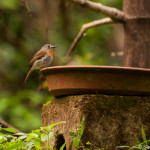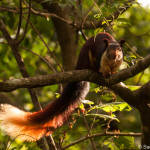The Old Magazine House at Ganeshgudi is the stuff of birdwatching legend. If you believed the stories, all you had to do was grab a cup of tea, take a seat in front of the birdbaths, and watch. It all sounded so fantastic that my husband, Kumar, and I had to go see it for ourselves.
The start of the trip was promising. As our taxi drove through a small country road, a hornbill flew overhead, bulbuls called incessantly, and kingfishers stood like sentinels over pools filled with lilies. We soon checked in to the Old Magazine House at Ganeshgudi and sighted the famous terracotta bird-baths. That first evening, at around 4pm, my fellow guests lined up in front of the baths with chairs, tripods, and long lenses. “This is ridiculous”, I thought to myself, “It’s almost like they are waiting for a theatre show.”
About half an hour later, as the first bird, a White-bellied Blue Flycatcher, heralded the start of proceedings, I was forced to eat my words. It was a show. And I watched it for three consecutive evenings. Now, what you will see at the Ganeshgudi bird-baths depends on the season, the day’s weather, and your birding luck. The days we were there, still early in the birding season, this spectacular sound and colour show began at about 5pm and ended only at 6.30pm.
If the bird-baths are a theatre stage, I can almost imagine the back-stage proceedings. The Racket-tailed Drongo, would, I imagine, be the director.
:::::::::::::
“Listen”, the Drongo says, “This is just the preliminary season, but we still need to make an impression. Who’s going on first?”
She turns to look at the White-rumped Shama, the star of this season’s show, but he’s too busy preening.
The small but intrepid White-bellied Blue Flycatcher puts up his wing. “I’ll start at the far end of the bird-baths, away from the big cameras.
Let’s tease them a little before we give them their money’s worth.”
Encouraged, the other flycatchers and thrushes line up for their roles. The Shama, it is decided, will appear on stage halfway through the show. He consents to staging a mock-fight with the Dark-fronted Babbler, so long as he (the Shama) is allowed to win. Meanwhile, the orchestra is readied. The cicadas are told to keep it down when the Malabar Whistling Thrush sings. The elderly hornbills give their blessing. All is set for a spectacular night.
:::::::::::::
My wild imagination apart, the bird-show is fun for both birdwatchers and normal folk. So long as you stay still and quiet, the birds seem unperturbed. They first appear on a distant branch, then fly here and there as though to disguise their intentions. Finally, they perch just about above the baths, before diving down for a drink or a bath. As the evening wears on, the activity gets more and more frenetic.
But you know what the best thing about the bird-show is? It is only a sign of what lies elsewhere. In the treetops beyond the little valley in the property, chattering langurs leap across the boughs. Malabar Giant Squirrels drape themselves over a branch to eat a snack, oblivious of their own beauty. Walking through the driveway yields more surprises. Butterflies swimming in the sunlight. Iridescent sunbirds flitting rapidly on a sugar-high. Red ants on a log. Yellow beetles. Spiders. Spider-hunters.
We walk to the forest checkpost nearby, and the guard helps us spot the many Malabar Grey Hornbills that live in the canopy above. They hop quietly over the branches, their eyes yellow and red in the sunlight. A short drive to the village reveals a tree full of shrill-voiced Hill Mynas. The last day, we ride in a coracle on the green waters of the Kali River. A Woolly-necked Stork watches as we float under her nest. A Pied Hornbill also bends down to look. Swallows and pigeons are nesting under the bridge and they erupt into flight as we coast nearby.
By now, I have lost count of the birds I have seen. “This is nothing. You must come back in summer when there are even more birds.”, says the naturalist. “Summer? You mean April or May?”, I ask. “No”, he says, “Summer. December or January.”
On the bus-ride that night, I wonder about this special Ganeshgudi summer. Even as dusty cities rush past, I can still see visions of birds whenever I close my eyes. I close my eyes again, and see three Malabar Grey Hornbills hanging upside down. “Why am I seeing them upside down?”, I ask the husband, not expecting a reply. “You are confusing the hornbills and the giant squirrels”, he says. I smile at my mangled memories and drift off to sleep. I hope to wake to the song of the Malabar Whistling Thrush, even if it’s only in my head.



















Enjoyed the post, including your upside-down memory 😀
Thanks Deepa! 🙂
I was in Australia in a place similar…burlee beach it was…nature and the life around us is awesome! Your imagined bird thoughts may not be too far from maybe what actually is!
Oh, good to hear. I lived in Australia for many years, but haven’t been to Burlee Beach.
Out of my curiousity, I did not see the photographs first. Instead I read the article first to feel the sense of your imagination. The vivid description of the environs and the chirping and dancing birds was mind blowing and let me tell you the beauty of the birds could be felt by the words more than the photographs! Enjoyed reading. Keep the pen flowing!
Sudhir, thank you for that! It might also be that I am better at making images with words than with pictures. 🙂
Dear Suchi
Thanks for the enchanting account eloquently expressed.I particularly liked the ‘back stage proceedings.’Reading your piece brought to my memory the great Rajaji’s remarks. Seeing a flight of green parrots sweeping across the sky,which he observed from the Governor General’s mansion(now the Rashtrapathi Bhavan) he said ” I am not sure of their address, but every morning they fly towards Palam, and return about this time(afternoon).See their puntuality,the precision of flight formation,the speed,manoeuvrability in the air and the obedience to the leader…………….These birds never collide or crash…But you should see them descending on a maize field.They bring themselves to a sudden halt and park themselves softly on the plants,almost hugging the mature corns.The natural camouflage of their plumes deceives the most alert gardener.”
I enjoyed your write up with the same admiration.
I have posted this in facebook. If it is not OK, i will remove.
Nice stuff to read from you.
Best wishes.
That’s perfectly fine Uncle! Thank you.
This was such a lovely read, Suchi! Loved the happenings backstage.
Thanks Anisha! I do keep checking your blog as well. 🙂